Upperman hosts “Welcome to the Library” fashion show
Students, staff, faculty and alumni came together in Kenan Auditorium on Feb. 9 for the Upperman African American Cultural Center’s annual fashion show. The production, organized every year as a part of UNCW’s homecoming and Black History Month festivities, featured live rappers, a local DJ and a rich collection of book-inspired student designs.
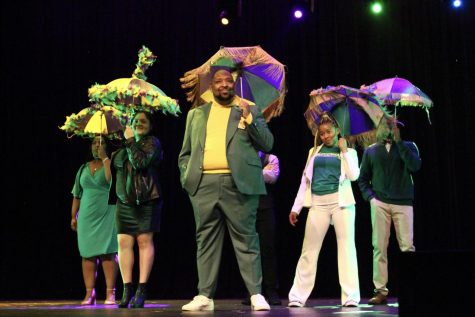
In the past few years, the COVID-19 pandemic made it difficult for models to make connections, both with each other and the audience, as social distancing required significantly less interaction at rehearsals, and masking left the audience unable to fully read the facial expressions and energy of the models on stage.
The theme of this year’s show, “Welcome to the Library,” is an ode to Black excellence in literature. Specially chosen to fit in with Upperman’s theme of “A is for Activism,” referring to student leadership and education, the fashion modeled in each scene represented a notable work by an author of color.
The books showcased were “If Beale Street Could Talk,” “Africa Must Unite,” “The Coldest Winter Ever,” “The New Negro,” “Their Eyes Were Watching God” and “Queen Sugar.”
“Not only are we doing ‘A is for Activism,’ but it is the 60th anniversary of Black student life here at UNCW, so we wanted to look at not just one time period but across the decades,” said Ashlee Fleming, program coordinator for Upperman. “That’s what we’ve been doing throughout the year so it kind of just falls in with the rest of our programming.”
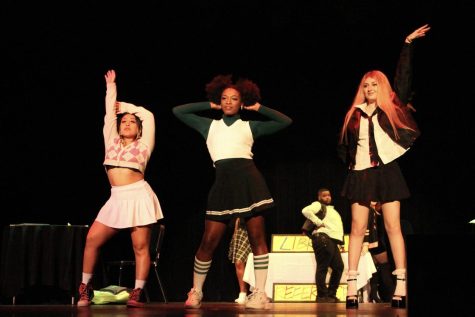
Sean Palmer, the director of Upperman African American Cultural Center, selected the books presented in each scene. Upperman students took on the positions of creative directors for individual scenes, choreography, color schemes and other facets of the show. The models themselves were not just students, but faculty and staff as well.
“This year, like every year, just gives our students and staff an opportunity to express themselves through a creative outlet,” said Fleming. “We do a lot of programming that’s academic or professional–speakers, lectures, stuff like that. As you see, Upperman is also able to execute a lot of programming that just revolves around culture, or in this instance, the intersection between culture and creativity, because we know that those two things are directly tied with each other.”
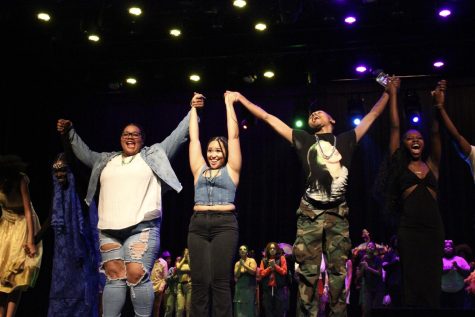
The DJ, Brandon “Bigg B” Hickman, is the program director for COAST 97.3, a local radio station, and a Wilmington native. He has been an active member in Upperman and the UNCW community and kept the audience engaged during transitions between scenes, playing a variety of songs by artists from Diana Ross to Tevin Campbell. One of the two featured rappers, Moe Holmes, or MoeSOS DC, is a UNCW alumni and former Upperman student leader. The opening scene, which was set in a library, featured Moe as a librarian, performing an original piece that he wrote specifically for the show.
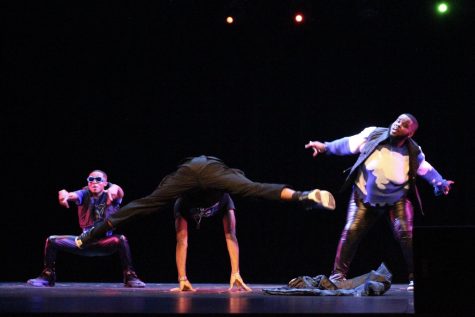
Each of the scenes had high energy and thorough choreography, while also allowing for all of the models to express themselves in a unique and personal manner. Some scenes were sponsored by designers and small businesses, and others had fashion brought in by the models themselves.
The second scene, “If Beale Street Could Talk,” had the models walking the runway in pairs in coordinated outfits of a classy collection of colors; black and white, red and white, and maroon. Several models dressed as waiters and, after presenting themselves to the audience, proceeded to walk around to the onstage tables with platters of fake food. Gender-fluid fashion, queer love, power, sass and class were all showcased proudly in the scene, which pulled from the famous novel by bestselling literary icon James Baldwin. Most of all, as with all the following scenes as well, it was clear that the models themselves were having just as much fun as the audience.
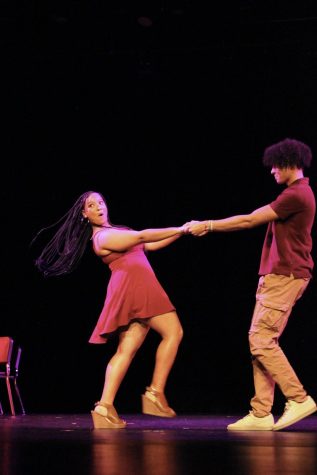
Scene three was based off of “Africa Must Unite” by Kwame Nkurumah. Models waved flags and scarves from across Africa while donning traditional clothing and presenting objects important to their respective country, such as Gambia and Mali. They also joined together in dance to music from various cultures throughout the continent.
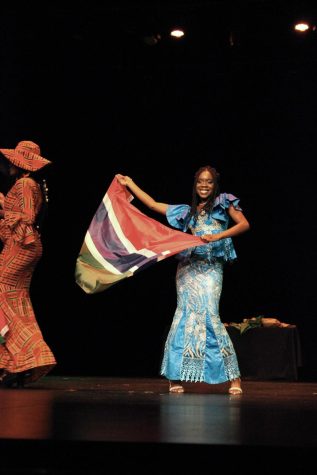
“One main thing this year is understanding parts of Africa,” said Taylor Holden, head of the executive board. “We [had] this one scene in our show, and in it we [had] two different types of songs that are based on Africa. One is East African music and one is West African music. A lot of people think that Africa is just the West Africans, but East Africans and West Africans are very different and it shows through the music and their style of dance.”
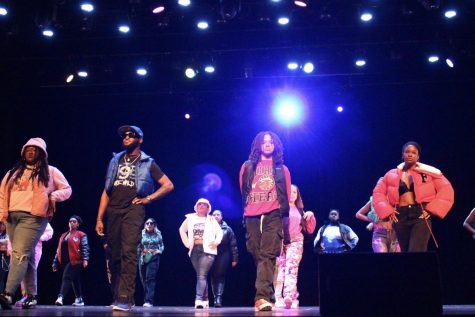
The fourth scene, “The Coldest Winter Ever,” brought the audience back to the United States, to Brooklyn, NY. With attitude and color-coordination, models strutted and danced to hip-hop music while flaunting both feminine and masculine energy in both outfit coordination and energy.
Scene five, “The New Negro,” is based on the essay and poetry anthology edited by Alain Locke, a leading figure in the Harlem Renaissance. Models traveled back in time to the roaring ’20s, stunning the audience in gorgeous, floor length dresses, suits and glitter while dancing in sneakers to everything from jazz to Beyoncé in what Bigg B referred to as the “sneaker ball”.
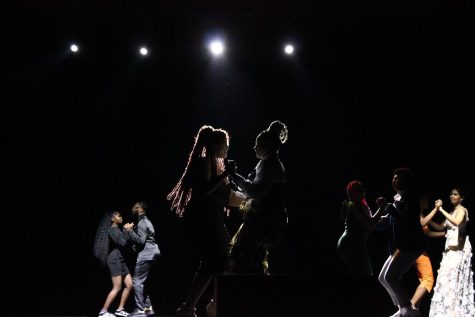
For “Their Eyes Were Watching God,” the Zora Neale Hurston novel which takes place in central and southern Florida during the early 1900s, models styled patterned, floral, summery clothing with brightly colored sunglasses and a diverse collection of hairstyles. Mardi Gras music and big band jazz played from the speakers as they left the stage, transitioning the show into its final scene: “Queen Sugar.”
“Our final scene is Mardi Gras because next year’s theme is Mardi Gras,” Deiona Stanley, executive board member, said. “There [was] a transition from the library to this parade-like vibe.”
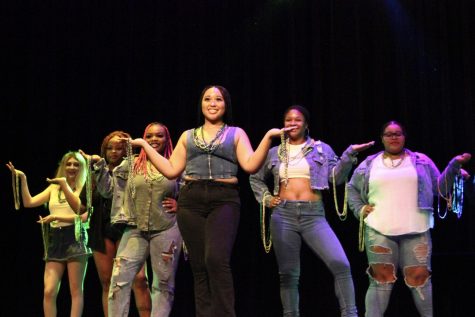
Contrastingly from the other scenes, “Queen Sugar” placed more emphasis on accessories, rather than whole outfits, as models wore a lot of basics. Each person on stage expressed themselves in a unique way, whether through accessorizing, choreography or even the attitude with which they strutted down the stage. In a mass of white, black, green and purple, the models paraded off the stage, rocking boas, large, colorful masks and special Mardi Gras umbrellas, a flamboyant finish to an already exciting show.
“I think that what makes the fashion show stand out is the fact that it’s a full experience,” Stanley said. “In other places, when you go to the fashion shows, the main focus is the clothing, but at Upperman we highlight the music and the people involved. We want to make the individual model feel like a superstar. The focus is on the experience, and there’s a story in every scene.”








